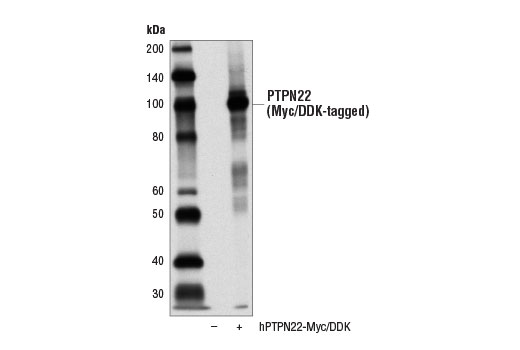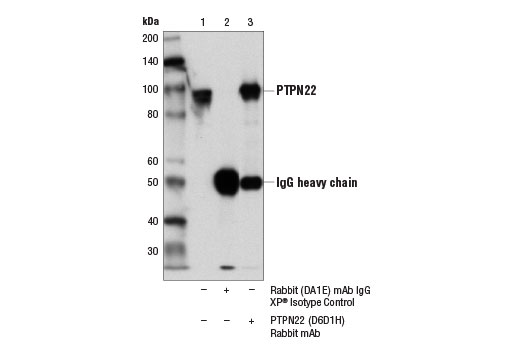WB, IP
H M
Endogenous
98
Rabbit IgG
#Q9Y2R2
26191
Product Information
Product Usage Information
| Application | Dilution |
|---|---|
| Western Blotting | 1:1000 |
| Immunoprecipitation | 1:100 |
Storage
Specificity / Sensitivity
Species Reactivity:
Human, Mouse
Source / Purification
Monoclonal antibody is produced by immunizing animals with a synthetic peptide corresponding to residues surrounding Pro451 of human PTPN22 protein.
Background
PTPN22 (Lyp/PEP) is a cytoplasmic phosphatase expressed by hematopoietic cells (1,2). PTPN22 associates with the tyrosine kinase Csk to inhibit T cell receptor signaling through inactivation of Src kinases (3,4). Csk phosphorylates Src kinases on an inhibitory tyrosine, while PTPN22 dephosphorylates an activating site (4). PTPN22(-/-) mice have higher levels of activated Lck than wild-type, resulting in greater T cell expansion and increased serum antibody levels (5). Research studies have shown that a single-nucleotide polymorphism, 1858T of the PTPN22 gene which encodes the amino acid substitution R620W, confers increased risk for multiple autoimmune diseases including type I diabetes, rheumatoid arthritis, systemic lupus erythematosus, and Graves disease (6-9). Interestingly, although the R620W substitution disrupts the interaction between Csk and PTPN22, it is actually a gain-of-function mutation resulting in increased phosphatase activity (6,10,11). Recent evidence suggests that the autoimmune phenotype associated with the R620W variant is the result of increased calpain-mediated degradation and decreased protein levels of PTPN22 (12).
- Cohen, S. et al. (1999) Blood 93, 2013-24.
- Matthews, R.J. et al. (1992) Mol Cell Biol 12, 2396-405.
- Cloutier, J.F. and Veillette, A. (1996) EMBO J 15, 4909-18.
- Cloutier, J.F. and Veillette, A. (1999) J Exp Med 189, 111-21.
- Hasegawa, K. et al. (2004) Science 303, 685-9.
- Bottini, N. et al. (2004) Nat Genet 36, 337-8.
- Begovich, A.B. et al. (2004) Am J Hum Genet 75, 330-7.
- Kyogoku, C. et al. (2004) Am J Hum Genet 75, 504-7.
- Velaga, M.R. et al. (2004) J Clin Endocrinol Metab 89, 5862-5.
- Vang, T. et al. (2005) Nat Genet 37, 1317-9.
- Rieck, M. et al. (2007) J Immunol 179, 4704-10.
- Zhang, J. et al. (2011) Nat Genet 43, 902-7.
Species Reactivity
Species reactivity is determined by testing in at least one approved application (e.g., western blot).
Western Blot Buffer
IMPORTANT: For western blots, incubate membrane with diluted primary antibody in 5% w/v BSA, 1X TBS, 0.1% Tween® 20 at 4°C with gentle shaking, overnight.
Applications Key
WB: Western Blotting IP: Immunoprecipitation
Cross-Reactivity Key
H: human M: mouse R: rat Hm: hamster Mk: monkey Vir: virus Mi: mink C: chicken Dm: D. melanogaster X: Xenopus Z: zebrafish B: bovine Dg: dog Pg: pig Sc: S. cerevisiae Ce: C. elegans Hr: horse GP: Guinea Pig Rab: rabbit All: all species expected
Trademarks and Patents
Limited Uses
Except as otherwise expressly agreed in a writing signed by a legally authorized representative of CST, the following terms apply to Products provided by CST, its affiliates or its distributors. Any Customer's terms and conditions that are in addition to, or different from, those contained herein, unless separately accepted in writing by a legally authorized representative of CST, are rejected and are of no force or effect.
Products are labeled with For Research Use Only or a similar labeling statement and have not been approved, cleared, or licensed by the FDA or other regulatory foreign or domestic entity, for any purpose. Customer shall not use any Product for any diagnostic or therapeutic purpose, or otherwise in any manner that conflicts with its labeling statement. Products sold or licensed by CST are provided for Customer as the end-user and solely for research and development uses. Any use of Product for diagnostic, prophylactic or therapeutic purposes, or any purchase of Product for resale (alone or as a component) or other commercial purpose, requires a separate license from CST. Customer shall (a) not sell, license, loan, donate or otherwise transfer or make available any Product to any third party, whether alone or in combination with other materials, or use the Products to manufacture any commercial products, (b) not copy, modify, reverse engineer, decompile, disassemble or otherwise attempt to discover the underlying structure or technology of the Products, or use the Products for the purpose of developing any products or services that would compete with CST products or services, (c) not alter or remove from the Products any trademarks, trade names, logos, patent or copyright notices or markings, (d) use the Products solely in accordance with CST Product Terms of Sale and any applicable documentation, and (e) comply with any license, terms of service or similar agreement with respect to any third party products or services used by Customer in connection with the Products.


